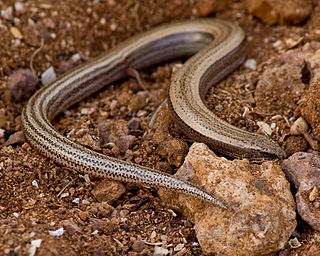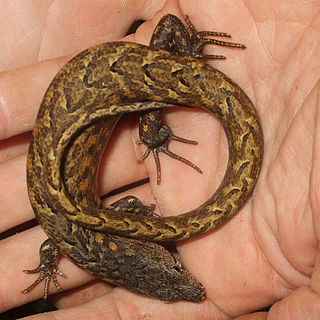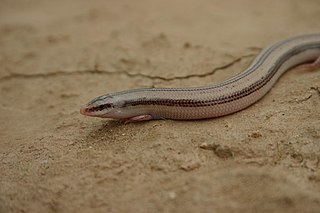
Skinks are lizards belonging to the family Scincidae, a family in the infraorder Scincomorpha. With more than 1,500 described species across 100 different taxonomic genera, the family Scincidae is one of the most diverse families of lizards. Skinks are characterized by their smaller legs in comparison to typical lizards and are found in different habitats except arctic and subarctic regions.

Ophiomorus is a genus of Old World skinks. The limbs are either reduced or absent, depending on the species. They are sometimes known as limbless skinks or snake skinks. Members of the genus live under rocks or in burrows.

The Bermuda skink, longnose skink, or Bermuda rock lizard is a critically endangered species and the only endemic land-living vertebrate of Bermuda. It is a relatively small skink : adults reach an average snout-to-vent length of about 8 cm (3.1 in).

Ophiomorus raithmai, known commonly as the eastern sand swimmer and the three-fingered sand-fish, is a species of skink, a lizard in the family Scincidae. The species is found in India and Pakistan.
Ophiomorus tridactylus, commonly known as the three-toed snake skink, is a species of skink endemic to sandy desert areas of South Asia. It is also called the Indian sand-swimmer for its habit of moving just under the sand.

Chalcides mauritanicus, or the two-fingered skink, is an African species of skink found in Algeria and Morocco. It occurs in sandy areas and plantations, but cannot exist in severely modified habitats. It also requires good ground cover, but as this is becoming increasingly scarce, the species is declining. The distribution of the species is severely fragmented. Females of the species give birth to live young.

The Gran Canaria skink is a species of skink in the family Scincidae which is endemic to Gran Canaria. Its natural habitats are temperate forests, temperate shrubland, Mediterranean-type shrubby vegetation, temperate grassland, rocky areas, sandy shores, pastureland, and plantations. The adults measure 16 – 18 cm out of which the tail forms 50%. Their legs are tiny, slim, and have five fingers. They live solitarily and only seek a partner during the mating season. They are ovoviviparous; females give birth to 2 - 4 babies after three months of pregnancy. They are kept as pets in vivariums.
Carinascincus palfreymani, known commonly as the Pedra Branca skink, as well as the Palfreyman's window-eyed skink, the Pedra Branca cool-skink, or the red-throated skink, is a species of skink in the family Scincidae. The species is endemic to Australia, and is restricted to the windswept Pedra Branca, an island off southern Tasmania of only 2.5 ha, where it is dependent on the seabird colonies. It is the only lizard species found on the island.

The chevron skink, is a large species of skink endemic to New Zealand, found only on Great and Little Barrier islands in the Hauraki Gulf. A cryptic forest dweller, it can hide underwater, and is under threat from introduced rats.

Latast's snake skink is a species of skink, a lizard in the family Scincidae. The species is endemic to the Near East.

The Greek snake skink is a species of skink, a lizard in the family Scincidae.

Carinascincus metallicus, the metallic cool-skink or metallic skink is a species of skink in the family Scincidae. It is endemic to Australia, found in southern Victoria, as well as in Tasmania where it is the most widespread and common lizard, occurring on many offshore islands in Bass Strait as well as the mainland. It gives birth to live young. It is highly variable in colour and pattern, and may be a complex of closely related species.

Scincinae is a subfamily of lizards. The subfamily contains 33 genera, and the genera contain a combined total of 284 species, commonly called skinks. The systematics is at times controversial. The group is probably paraphyletic. It is one of three subfamilies of the family Scincidae, the other two being Acontinae and Lygosominae.

Maranjab's snake skink is a species of skink, a lizard in the family Scincidae. It can be found in north-east of Kashan, Dasht-e Kavir, Iran. From snout to vent 95 mm, tail 81 mm.

The Persian snake skink is a species of skink endemic to Iran. A specimen collected in 1999 was found on sandy clay soil near Artemisia shrubs. It was originally described in 1867 as Hemipodion persicum.
Ophiomorus blanfordii, also known commonly as Blanford's snake skink, is a species of lizard in the family Scincidae. The species is native to Western Asia and South Asia.
The short-legged snake skink is a species of skink, a lizard in the family Scincidae. The species is from Afghanistan, Pakistan, and Iran.
Chernov's snake skink is a species of skink, a lizard in the family Scincidae. The species is native to Western Asia and Central Asia.
Ophiomorus kardesi is a species of skink, a lizard in the family Scincidae. The species is from Turkey.

Ophiomorus nuchalis, the Nilson's snake skink or plateau snake skink, is a species of skink, a lizard in the family Scincidae. The species is endemic to Iran.














